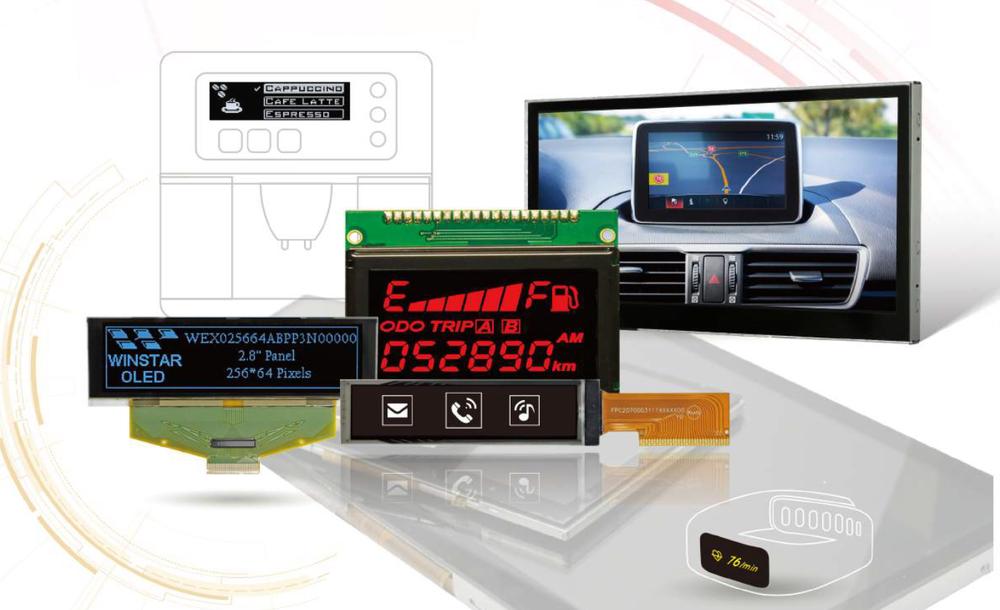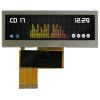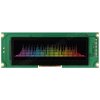LCD is proven and constantly improving technology, while OLED is still a relatively new technology for industrial applications. Which one to prefer?
To make your decision a bit easier, we summarised basic “pros and cons” of both technologies.
Today, more and more applications are using the display. Whether as a means to display the desired information or as an interactive element (HMI- human-machine interface) with a touch panel.
When choosing a display, we should consider these criteria primarily:
1. Display demands on the performance of the host processor and application development
- Classic character displays with some of the standard controllers are the least demanding because the required content is displayed only on the basis of the codes sent - we do not care about the content of individual pixels. This also implies that the development of character display applications is the least difficult.
- Monochrome graphical displays are considerably more demanding on the host processor, but thanks to the integrated controller the control is relatively easy and modern controllers (together with the firmware from the manufacturer) make it possible to simplify application development significantly.
- Full colour (RGB) graphical displays are naturally the most demanding to use, but they offer the most sophisticated ability to display any content.
2. Display Intelligence
Previous statements about the demands on the host (master) controller as well as on the development/complexity of the application apply only to standard displays without added intelligence.
However, there are already a variety of display module families on the market that incorporate a powerful graphics processor and firmware, which along with the development software (that is almost always available for free) can significantly simplify the development of graphics applications. The performance of the used processors is in many cases also sufficient to control the surrounding components, so that the entire application can be built on the basis of the display module, without the need for an additional microcontroller.
Intelligent displays of such kind are for example:
- UniTFT from Electronic Assembly
- all modules from 4D Systems,
- EVE family from Bridgetek
- - and partially also the eDIPTFT family from Electronic Assembly.
3. Touch panel
Almost every display can now be fitted with a touch panel - resistive or capacitive. Even OLED industrial displays are already becoming available with touch panels.
Although the ease of control and perhaps the habit from smartphones tempts us to use a capacitive display, it is not optimal everywhere. The ability to operate the resistive panel even with normal gloves is still a big advantage. Still, the touch panel slightly worsens the contrast and brightness of the display, so if the brightness of the display is a priority, it is better to use the display without the touch panel.
4. Light conditions (Ambient light)
The LCD display can be with or without backlight. The vast majority of available displays now have a backlight, allowing the display to be readable in darkness or dark environments.
However, under strong ambient light, and particularly in direct sunlight, the backlight is usually relatively dim, and the readability of the displays in the sun is significantly impaired. However, there are also exceptions where it is possible to maintain fair readability of the displays even in direct sunlight thanks to the technology used and the relatively powerful backlight.
OLED displays also suffer from significantly reduced contrast in direct sunlight, but some types provide acceptable readability even under such conditions.
5. Operating temperatures range
It can be stated that there are several display technologies on the market, but the absolute majority of display types use some analogue of LCD (STN, FSTN, TFT, IPS ..) or OLED. Some advanced technologies - such as VFDs (vacuum fluorescent display) are still available but are only beneficial for some specific cases, like operation in frosts with low power consumption at the same time.
So, knowing that even a modern IPS TFT panel is still a liquid-crystal display in its essence, it implies one fundamental fact - its reaction times and usually the contrast and viewing angles have a significant effect on temperature changes. However, even in LCD technology, we can find types capable of working in the range of -30 ... + 85°C, but it should be taken in mind that the characteristics of the display at the limit temperatures will no longer be optimal.
OLED displays, on the other hand, break down low-temperature barriers and work seamlessly at -40°C without compromising performance.
When selecting a display, it is therefore important to consider the temperatures at which the display will work, and in addition to allowing the extraordinary temperature conditions that may occur in the application environment. To learn more about the effect of temperature on display life, see our article Check the limits of your display.
LCD or OLED? Summary
Although it may seem that OLED technology is a winner, let's take a look at the current market situation for OLED displays suitable for industrial applications:
- The price of OLED display is about 1.5-4x higher than the LCD alternative.
- Types available for industrial applications are almost exclusively PMOLED (passive matrix)
- OLED alternatives are already available for many classic character displays (2x16, 4x20, etc.), with characters of the same size and identical or very similar mechanical dimensions and pin layout
- In the vast majority of cases, only monochromatic OLEDs are available. Full-colour RGB versions are available only in small sizes - approx. 1.4 "-1.7".
- Larger sizes of RGB OLEDs (as we know them from today's smartphones) are available only exceptionally and usually have a very short availability, so they are not suitable for devices manufactured for many years
- The best readability and lifetime (electric) have yellow OLED; white colour is also quite good. This is also reflected in the market offer where green, blue and red are available on a significantly smaller scale
- Power consumption of a fully lit (all pixels) OLED display may be comparable or even higher than that of an LCD with backlight, but in practice, the entire display is rarely used, and so the OLED alternative consumption is usually lower
- The contrast and viewing angles are of course excellent, as we have already described in several of our articles
- Readability of OLED in the sun is noticeably deteriorating and, although relatively acceptable, specialized LCDs (particularly transflective) can achieve better contrast in direct sunlight
We hope this summary will help you choose the best display for your application.
The display market and manufacturers' offerings are evolving very quickly, but we can supply any display upon request, either in sample quantities or in mass quantities. Therefore, if you have not found a display suitable for your application in our range, do not hesitate to contact us.
For more information about displays, please do not hesitate to contact us at sales@soselectronic.com
Do you like our articles? Do not miss any of them! You do not have to worry about anything, we will arrange delivery to you.

































